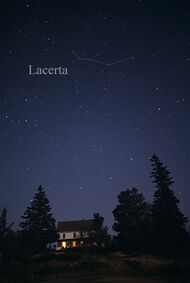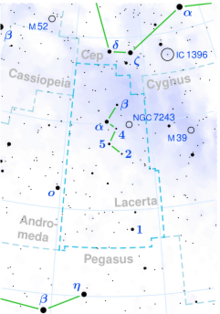Astronomy:2 Lacertae
| Observation data Equinox J2000.0]] (ICRS) | |
|---|---|
| Constellation | Lacerta |
| Right ascension | 22h 21m 01.54727s[1] |
| Declination | +46° 32′ 11.6461″[1] |
| Apparent magnitude (V) | 4.53 – 4.56[2] |
| Characteristics | |
| Spectral type | B6V[3] (B6IV + B6V)[4] |
| U−B color index | −0.49[4] |
| B−V color index | −0.14[4] |
| Variable type | Ellipsoidal (suspected)[5] |
| Astrometry | |
| Radial velocity (Rv) | −9.5±2[6] km/s |
| Proper motion (μ) | RA: 22.35[1] mas/yr Dec.: 1.45[1] mas/yr |
| Parallax (π) | 5.88 ± 0.14[1] mas |
| Distance | 550 ± 10 ly (170 ± 4 pc) |
| Absolute magnitude (MV) | −1.19[7] |
| Orbit[4] | |
| Period (P) | 2.616430±0.000003 yr |
| Eccentricity (e) | 0.040±0.018 |
| Periastron epoch (T) | 2427770±0.18 |
| Argument of periastron (ω) (secondary) | 97.4±25.3° |
| Semi-amplitude (K1) (primary) | 79.5±1.8 km/s |
| Semi-amplitude (K2) (secondary) | 100.0±1.8 km/s |
| Details | |
| primary | |
| Mass | 6.99[8] M☉ |
| Surface gravity (log g) | 3.0[4] cgs |
| Temperature | 15,000[4] K |
| Rotational velocity (v sin i) | 50[9] km/s |
| secondary | |
| Mass | 5.55[8] M☉ |
| Rotational velocity (v sin i) | 35[9] km/s |
| Other designations | |
| Database references | |
| SIMBAD | data |


2 Lacertae is a binary star in the constellation of Lacerta. With an apparent magnitude of about 4.5, it is faintly visible to the naked eye. Its parallax, measured by the Hipparcos spacecraft, is 5.88 milliarcseconds,[1] corresponding to a distance of about 550 light years (170 parsecs). It is projected against the Lacertae OB1 stellar association to the northeast of the main concentration of stars, but it is likely to be a foreground object.[7]
2 Lacertae is a double-lined spectroscopic binary. Its components are too close to be resolved, however periodic Doppler shifts in its spectrum reveal that there are two stars orbiting each other. Both stars are B-type main-sequence stars, orbiting each other every 2.616 days and with an eccentricity of about 0.04. The primary is estimated to be about one magnitude brighter than the secondary. The primary component is close to moving off the main sequence, and has nearly exhausted its core hydrogen (possibly also its companion).[4] It is estimated to have completed over 90% of its time on the main sequence.[11]
2 Lacertae is a rotating ellipsoidal variable, a binary system in which the stars are close enough to each other for one or both stars to be significantly distorted by tidal forces. The stars' orbital plane is not aligned closely enough to our line of sight for the stars to eclipse each other, but the stars' orbital motion does cause us to view different portions of the non-spherical stars' surfaces, leading to brightness changes. 2 Lacertae varies by about 0.03 magnitudes as the stars orbit each other.[2]
References
- ↑ 1.0 1.1 1.2 1.3 1.4 1.5 van Leeuwen, F. (2007). "Validation of the new Hipparcos reduction". Astronomy and Astrophysics 474 (2): 653–664. doi:10.1051/0004-6361:20078357. Bibcode: 2007A&A...474..653V.
- ↑ 2.0 2.1 "NSV 14130". AAVSO. https://www.aavso.org/vsx/index.php?view=detail.top&oid=52754.
- ↑ Lesh, Janet Rountree (1968). "The Kinematics of the Gould Belt: An Expanding Group?". Astrophysical Journal Supplement 17: 371. doi:10.1086/190179. Bibcode: 1968ApJS...17..371L.
- ↑ 4.0 4.1 4.2 4.3 4.4 4.5 4.6 Hilditch, R. W. (1974). "The binary systems 14 Cephei and 2 Lacertae". Monthly Notices of the Royal Astronomical Society 169 (2): 323–329. doi:10.1093/mnras/169.2.323. Bibcode: 1974MNRAS.169..323H.
- ↑ Samus, N. N. et al. (2009). "VizieR Online Data Catalog: General Catalogue of Variable Stars (Samus+ 2007-2013)". VizieR On-line Data Catalog: B/GCVS. Originally Published in: 2009yCat....102025S 1. Bibcode: 2009yCat....102025S.
- ↑ Wilson, Ralph Elmer (1953). "General catalogue of stellar radial velocities". Washington. Bibcode: 1953GCRV..C......0W.
- ↑ 7.0 7.1 Kaltcheva, Nadia (2009). "Lacerta OB1 Revisited". Publications of the Astronomical Society of the Pacific 121 (884): 1045–1053. doi:10.1086/606037. Bibcode: 2009PASP..121.1045K.
- ↑ 8.0 8.1 Kraicheva, Z.; Popova, E.; Tutukov, A.; Yungelson, L. (July 1980). "Catalogue of physical parameters of spectroscopic binary stars.". Bulletin d'Information du Centre de Donnees Stellaires 19: 71. ISSN 1169-8837. Bibcode: 1980BICDS..19...71K.
- ↑ 9.0 9.1 Abt, Helmut A.; Boonyarak, Chayan (November 2004). "Tidal Effects in Binaries of Various Periods". The Astrophysical Journal 616 (1): 562–566. doi:10.1086/423795. Bibcode: 2004ApJ...616..562A.
- ↑ "MAST: Barbara A. Mikulski Archive for Space Telescopes". Space Telescope Science Institute. https://mast.stsci.edu/portal/Mashup/Clients/Mast/Portal.html.
- ↑ Zorec, J.; Royer, F. (2012). "Rotational velocities of A-type stars. IV. Evolution of rotational velocities". Astronomy & Astrophysics 537: A120. doi:10.1051/0004-6361/201117691. Bibcode: 2012A&A...537A.120Z.
Coordinates: ![]() 22h 21m 01.6s, +46° 32′ 12″
22h 21m 01.6s, +46° 32′ 12″
 |


